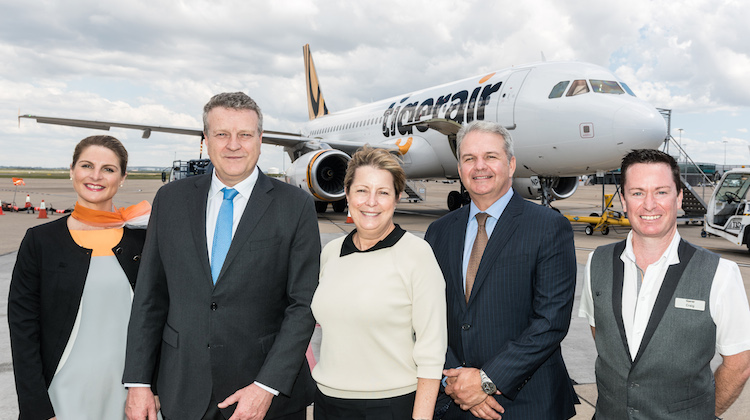
Tigerair Australia plans to add a fourth Boeing 737-800 to its fleet to assist with crew training and for additional domestic flights over the busy summer holiday season.
The 737-800 from parent Virgin Australia is expected join the fleet in December, a Tigerair spokesperson told Australian Aviation via email.
To be based in Melbourne, the aircraft will be rebranded into Tigerair livery and have its cabin reconfigured.
The arrival of a fourth 737 from parent Virgin is not part of Tigerair’s transition from A320s to 737s that was announced in July, where the 14 A320s will be progressively replaced with Boeing 737s over the next three years as Virgin and Tigerair move to a common fleet type.
Rather it represents additional capacity, with Tigerair’s fleet to increase to 18 aircraft – 14 A320s and four 737s – and is a further sign the airline is continuing to gain traction at the budget or leisure end of the market after delivering its maiden profit in 2015/16.
Currently, Tigerair’s three ex-Virgin 737-800s are used for the low-cost carrier’s flights to Bali from Adelaide, Melbourne and Perth and configured with 180 all-economy seats with five extra-legroom rows available for purchase as an optional extra.
The aircraft are flown by Virgin pilots alongside Tigerair cabin crew and remain on Virgin Australia International’s air operator’s certificate (AOC).
Tigerair has applied to the Civil Aviation Safety Authority (CASA) for two changes to its AOC.
The first is for the addition of the 737 onto its AOC as it transitions from Airbus to Boeing equipment, with pilot training for the 737 already underway. The second is to secure approval to operate international flights.
The Tigerair spokesperson told Australian Aviation the AOC was expected to be updated in time for its own pilots to operate the Boeing narrowbody on domestic routes by the time summer rolls around.
And when the AOC is updated for international flights, Tigerair would be able to to transfer those 737s onto its own AOC.
“The 4th 737 aircraft will initially be used for crew training purposes in order to support our international services to Bali and then for additional domestic flying over the summer months on popular routes,” the Tigerair spokesperson said.
Tigerair reported full year underlying earnings before interest and tax (EBIT) of $2.2 million for 2015/16, up from a loss of $37.1 million a year ago. It was the first full year profit since the airline started flying in Australia under different owners in 2007 and came a year earlier than was targeted when Virgin took full ownership of the airline in 2014.
Figures from aviation thinktank CAPA – Centre for Aviation showed Tigerair had about a six per cent capacity share of the domestic market.
While it was a “relatively modest figure”, and up only slightly since the airline’s transformation program commenced in mid-2013 when Virgin took its initial 60 per cent stake, CAPA said it was “sufficient to give the Virgin Australia group a play in the price-sensitive leisure sector”.
“The current focus may limit growth opportunities but provides a sustainable niche with a strong prospect of continued profitability,” CAPA said in a research note dated August 16.
“As it approaches its tenth anniversary Tigerair Australia is finally profitable, and has a relatively certain future.”
A fourth 737 at Tigerair’s Tullamarine base has also facilitated the transfer of one A320 from Melbourne to Brisbane.
Tigerair said on Thursday it would have three A320s based in Brisbane from March 2017, up from two currently, and allow the airline to boost its network from the Queensland capital.
The airline will launch new Brisbane-Whitsunday Coast and Brisbane-Perth services on March 23 and June 1 2017, respectively, and add more flights from Brisbane to Cairns and Brisbane to Adelaide, as well as on the Sydney-Whitsunday Coast route.

Tigerair chief executive Rob Sharp said the extra services represented about 225,000 additional seats a year at Brisbane Airport.
“The sunshine state is an integral part of our network with over 70 per cent of all Tigerair domestic services already touching Queensland,” Sharp said in a statement on Thursday.
“That number is set to increase with all the new services announced today.
“We are confident our new services will prove popular with our core market of budget and leisure travellers, whilst at the same time stimulating numerous benefits for the city of Brisbane by way of increased tourism expenditure and job creation.”
Brisbane Airport chief executive Julieanne Alroe said the Tigerair commitment of an additional aircraft would offer travellers “more choice, flexibility and competitive pricing than ever before”.
“The importance of this investment, which will bring significant positive returns to our economy, cannot be over-estimated,” Alroe said.
“I congratulate CEO Rob Sharp and the Tigerair team on today’s announcement and we look forward to supporting these new operations and building on the strong partnership that’s already developed between BAC and Tigerair.”
Once the A320 is shifted to Brisbane, Tigerair will have six A320s in Melbourne. Its third base, Sydney, has five A320s.










